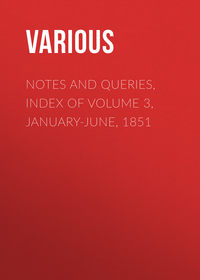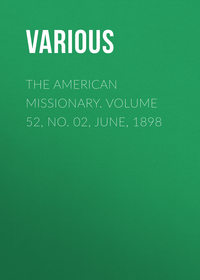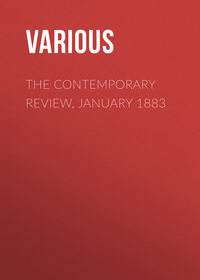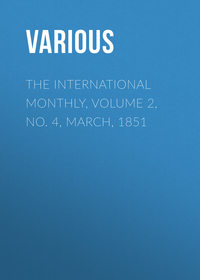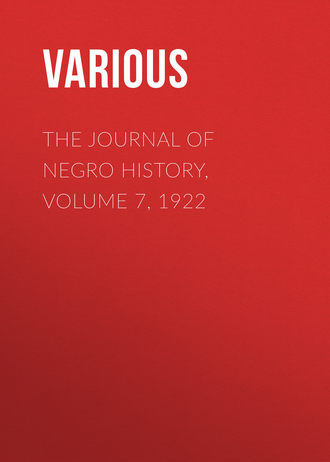 полная версия
полная версияThe Journal of Negro History, Volume 7, 1922
On the day the Committee finally revised the bill and voted on it, Congressman Goldfogle was suffering intensely from carbuncles, and was about to undergo a surgical operation. Despite this, he went to the committee meeting, and there moved the insertion of the provision for the appropriation for a Negro exhibit.
Some members of the committee who were not favorable to the project and others who were quite indifferent to it urged the Congressman to allow the matter to remain in abeyance, saying that it might be taken up at some future time. Judge Goldfogle, however, insisted there was no time like the present and that the colored men and women of the country ought to have an opportunity to show through means of the proposed exhibit the remarkable progress that they had made since the days when they emerged from slavery. In the course of his remarks to the Committee, he said that he came of a race that had been oppressed and which centuries ago had been in slavery, and that had he lived forty years after the children of Israel had passed out of the house of bondage, he would have been thankful and grateful had anyone given his people an opportunity to show the progress they had made as free men.
Congressman Goldfogle called attention to the testimony that had been given during the hearings before the Committee of the great advancement made by the colored people in every avenue of life from the time of their emancipation, and the credit that was due to many of the men and women of the Negro race who had shown themselves worthy of the freedom that happily this country accorded them.
After quite a spirited debate, in which Judge Goldfogle warmly espoused the cause of the colored man, the Committee, by a majority of one vote, inserted the appropriation provision; and thus, mainly through the efforts of this New York Congressman, who has not a single colored vote in his district, the Negro exhibit was established at the Jamestown Exposition.
BOOK REVIEWS
A Social History of the American Negro. By Benjamin Brawley. Macmillan Company, New York, 1921. Pp. 420.
As Negro history has been so long neglected, it will require some time to develop in this field the necessary standard to secure a distinction between the significant and insignificant and between truth and fiction. On account of the emphasis which has been recently given to this study, many novices lacking especially the historical point of view have entered this field because it is so productive that it is an easy task to write a work therein. Benjamin Brawley whose chief preparation and efforts have been restricted to English is one of these novices. Among his first efforts were A Short History of the American Negro and The Negro in Literature and Art. In neither of these works does he exhibit the knowledge required by the standards of present day historiography. This more recent work although more extensive than the others has no better claim to its being called history.
There can be no question as to many valuable facts contained in this work, but it lacks proportion, style, and accuracy. The book begins with a study of African origins based largely on Wiener's Africa and the Discovery of America and upon Lady Lugard's Tropical Dependency. He next takes up the Negro in the Spanish exploration but has little or nothing to say about the Negroes in connection with other explorers. His treatment of the development of the slave trade and of the introduction of slavery shows a slightly improved conception of his task. In his discussion of the Negroes in the colonies, into which he works servitude and slavery, the Indian, the mulatto, the free Negro, and efforts for social betterment, he presents a veritable hodgepodge. Passing then to the study of the estrangement from Great Britain, the participation of the Negro in the Revolutionary War, and the effect of that movement upon the Negro's social and political situation, he exhibits no scientific grasp of the status of the Negroes during the eighteenth century or of what they were thinking and doing. The treatment of the new West, the South, and the West Indies, which follows this portion of the book is merely certain generalizations which may be obtained from an average knowledge of American history and from such topical discussions of the Negro history as may be found in B.A. Johnson's History of the Negro Race or in John W. Cromwell's The Negro in American History. In his discussion of the Indian and the Negro there is an effort which serves to direct attention to a neglected aspect of our history, that is, to figure out the extent to which the races were associated and the race admixture which resulted from such contact.
Coming nearer to our day to take up the discussion of the Missouri Compromise, the abolition agitation, and the constitutional debate on slavery, Mr. Brawley shows his inability to develop his subject for he merely draws a few facts first from one field and then from another to fill out certain topics in the book without correlating them in such a way that the reader may be able to interpret their meaning. He has endeavored not to write a history but to summarize what other persons are now publishing as selected topics in this field. In other words, he has added to the unscientific history of the Negro, which has hitherto appeared in the so-called text books on Negro history, facts culled from various sources but so improperly used as not to develop the subject.
The chapter on Liberia should have been incorporated into the treatment of colonization or made a supplementary chapter in the appendix of the book. Placed in the middle of the work, it has been necessary to repeat certain facts which could have been stated elsewhere once for all. The same is true of his treatment of the Negro as a national issue, and of social progress, which he takes up the second time as topics inadequately developed in the earlier stages of the treatise. In his discussion of the Civil War, the Emancipation, the Reconstruction, and the Negro in the new South, he says very little which is new. Under the caption The Vale of Tears, he drifts almost altogether into opinion as he does also in the case of the Negro in the New Age and the Negro Problem. Judging, then, from the point of view of an historian, one must conclude that this work does not meet any particular want and that so far as the history of the Negro is concerned the publication of it will hardly result in any definite good. Mr. Brawley does not know history.
William Lloyd Garrison. By John Jay Chapman. Moffat, Yard and Company, New York, 1913. Pp. 278.
This is a revised edition of a work of a similar name by this author, published in 1913 by Moffat, Yard and Company, New York. After having written the first edition the author made further investigation and had other reflections which led him to think and to see things from a different angle. He was impressed, moreover, with the fact that, being now further removed from the Civil War, persons have learned to think more seriously with regard thereto and to consider the value of the deeds of the participants therein in a more sympathetic manner. This work, however, has not been so very much enlarged; for it has only eighteen pages more, but unlike the first edition it has an index. Hoping, however, to give the subject of this sketch a larger place in American history and to popularize the story of his career this revised edition has been given to the public.
The work is not set forth as a scientific study. It is rather an abridged account which may be read without much difficulty by the average student in quest of concise opinion concerning one of the most important American characters figuring in that great crisis between 1830 and 1860. On reading this work, one receives the impression that the author has done his task very well. It borders somewhat on hero worship, however, as is evident from the use of the following language: "If one could see a mystical presentation of the epoch, one would see Garrison as a Titan, turning a giant grindstone or electrical power-wheel, from which radiated vibrations in larger and in ever larger, more communicative circles and spheres of agitation, till there was not a man, woman, or child in America who was not a tremble." He says further: "We know, of course, that the source of these radiations was not in Garrison. They came from the infinite and passed out into the infinite. Had there been no Garrison they would somehow have arrived and at some time would have prevailed. But historically speaking they did actually pass through Garrison: he vitalized and permanently changed this nation as much as one man ever did the same for any nation in the history of the world."
The book gives a good background and then dramatically stages Garrison as a striking figure. Next follows a dramatic presentation of the antislavery struggle with pen pictures of the participants. The story finally reaches the crisis when Garrison stood as a central figure. The work contains a retrospect and a prospect, an excellent account of the man in action, the Rynders Mob, Garrison and Emerson, and foreign influence. The story closes with a summary and an impressive epilogue. Although not a scientific treatise it certainly furnishes stimulus to further study, and when a student thus interested has read it, he will desire to study one of the larger biographies of this distinguished man.
The Education of the South African Native. By Charles T. Loram. Longmans, Green and Company, London, 1917. Pp. 340.
This is a treatise written by a South African brought up among the natives. He was once a Fellow in Teachers College of Columbia University. At the time of writing this book he was serving as an inspector of schools in Natal. The study, however, was undertaken as a doctoral dissertation at Columbia.
Observing the shortcomings of writers on Africa, this author endeavors to make a step ahead of them. He feels that they have dealt too much with ethnology, and with the descriptions of customs and habits. He does not think very much of the books primarily devoted to a discussion of the conflicting opinions on craniology and psychology of the natives. Taking up his own chosen task, however, he found it rather difficult because the government has had no definite policy of native education, and when there has been a policy among the four important South African governments there does not appear to be any uniformity of effort. No one, moreover, has undertaken to give the problem of the uplift of the natives adequate treatment.
The author desired to make his work scientific but it appears that he had not prosecuted this study very far before he found that important facts were lacking and that in making his conclusions and suggestions he would have to rely upon faith that what he may surmise may in the future prove to be true, although some modification may be necessary. Taking up this problem of education, however, he made use of the reports of the government departments, reports of school officials, books, pamphlets, articles in periodicals, statistical and experimental investigations, personal experience, and the experiences of his colleagues. While the work for the lack of some scientific treatise blazing the way suffered from so many handicaps that it could not be thoroughly scientific, it is the nearest approach to it and must be considered the best authority in this field until superseded.
The work begins with a consideration of such scientific topics as race contact in its larger aspects, the native problem and its proposed solution, serving as a sort of introduction to the essential portion of the work. The chief value of the book lies in its consideration of why the natives should be educated, the early missionary enterprises, the present status, elementary, industrial and higher education of the natives, a comparison of the achievements of native education with that of European, the basis for reconstruction of the native system, the educational budget, and proposed changes.
The work is generally readable but grows a little dull in certain statistical portions. The table of contents is detailed, but the book could have been considerably improved had an index been added. On the whole, the volume is a justification of some change in the political status of the Negro for the good of all. South Africa cannot in its own interest neglect the uplift of the natives, if it would promote the social and economic progress of the whole group. The one element cannot be elevated or kept up while the other is being held down. Persons interested in education of belated peoples and in the missionary enterprises should avail themselves of this volume.
From Slave to Citizen. By Charles M. Melden. The Methodist Book Concern, New York and Cincinnati, 1921. Pp. 271.
This is a work written by one who has spent sixteen years as an educator of Negroes in the South. His experience there was sufficient for him to learn the Negro and his needs and he writes in the vein of one speaking as having authority. Because of his long service among the Negroes, the author has doubtless caught the viewpoint of the aspiring members of the race. He aims, therefore, to present the Negro's claim for recognition as a man, as a member of the human family with the implied rights and privileges belonging to him.
The book presents a definite program. It proceeds on the basis that, in a democracy, citizenship with its duties and its privileges must in the long run be recognized. He does not feel that democracy means the wiping out of racial preferences but the recognition of racial gifts and endowments. The author considers it an injustice to hold the Negro to the standards of democracy without training him to meet the responsibility. He considers it unfair to require every individual of the race to reach a prescribed standard before any of that group shall be recognized. It is, therefore, a plea for treating the Negroes as individuals and not as a single group, for fair treatment will not lead to amalgamation in as much as Christianity has not been known to promote that.
The chief remedy for the evils of racial conflict, according to the author, is cooperation. This must be brought about through growth and development from the contact of the two races on the higher plane of Christian service. Men must learn to work together without surrendering their fundamental connections. They must confer on all matters pertaining to economic welfare. This means that the white man must give the Negro a chance for initiative and leadership in the program of cooperation rather than the eternal superimposed leadership from without. In the language of Bishop W. P. Thirkield, who wrote the introduction to this work: "The Negro must be offered not crutches but a spirit of cooperation to make him strong that he may stand on his feet and walk."
It is evident then that this book is primarily concerned with the solution of the race problem. Yet written by a man who for years lived in the South, it presents a point of view which will be of value to the historian. From such topics as citizenship, social and legal discrimination, disfranchisement, and mob law, the historian will learn much by observing how these things impressed this worker in the South and his reaction on them. Valuable information may be obtained also from the discussion of the work of the Christian teacher in the South, the mission school, and the silent protest in the form of the exodus. There are valuable statistics in the chapters presenting the progress in education, advancement in wealth, achievement in social uplift, attainments in literature and art, and the record of the Negroes in the World War. The last part of the book concerned with the currents and counter-currents, the grinding of the mills of the gods and a possible modus vivendi will decidedly interest the social worker but will not concern very much the student of history. On the whole, however, this volume is a valuable historical document which the student of Negro life must read to be well informed as to what the Negro has been doing in the South during the last generation and what others have been doing for him.
NOTES
The annual meeting of the Association, held at Lynchburg on the 14th and 15th of November, was the most successful conference hitherto held by this organization. The proceedings appear elsewhere in this number.
At this meeting Prof. John R. Hawkins, for years a member of the Executive Council, was elected President. A new Secretary-Treasurer, Mr. S. W. Rutherford, was also elected. Mr. Rutherford is a well-known business man in Washington. The Executive Council was reconstructed to make it national. The following persons were added thereto: Bishop R. A. Carter, R. R. Church, John W. Davis, Clement Richardson, and R. C. Woods. Most of the former members of the Executive Council were retained.
The Associated Publishers, Incorporated, Washington, D. C., have brought out C. G. Woodson's History of the Negro Church. A review of this work will appear in the next number. Another work, the Negro in Our History, will be published some time in March.
The Journal of Negro History has received for review Mason and Furr's With the Red Hand of France, an account of a regiment of Negro soldiers in France with the American Expeditionary Force.
A group of intelligent Negroes in North Carolina have formed a state historical society to preserve the records of the race in that commonwealth.
Dr. C. G. Woodson, the Director of the Association is now making a study of slavery from the point of view of the slave himself. He has sent out a searching questionnaire from which some results are being obtained. He is also consulting local records and documents left by slaves themselves and by those in a position to know their attitude toward the institution. The cooperation of all interested in unearthing the truth is earnestly solicited.
Professor A. A. Taylor, of the West Virginia Collegiate Institute, is now making a scientific study of the influence of the Negro congressmen on the legislation of Congress and on the general policy of the country. He will appreciate any facts which may not be covered by the public documents and books available.
Duffield and Company of Boston have published a new edition of Benjamin Brawley's The Negro in Literature and Art.
PROCEEDINGS OF THE ANNUAL MEETING OF THE ASSOCIATION FOR THE STUDY OF NEGRO LIFE AND HISTORY, HELD AT LYNCHBURG, NOVEMBER 14 AND 15, 1921
The morning session of the annual meeting of the Association on the 14th at the Virginia Theological Seminary and College was called to order by the Director, C. G. Woodson, who briefly traced the history of the organization showing how it had gradually gained influence and power and reached the position which it now occupies as a national organization of concern to the people of both races throughout the country. The Director then introduced Professor Charles H. Wesley of Howard University, who delivered a most instructive and inspiring address on the value of Negro History. After a few remarks by Dr. R. C. Woods, a number of persons expressed their interest in the Association by becoming members.
At two o'clock in the evening, the business session of the Association was held. From the Executive Council, there was presented a recommendation for the following amendments to the constitution, which, after some discussion, were adopted by the Association:
That Article IV be amended so as to change "twelve" to "fourteen," and to incorporate after the words "business committee" therein the words "to fix salaries of employees." This article would then read as follows:
The Officers of this Association shall be a President, a Secretary-Treasurer, a Director and Editor, and an Executive Council, consisting of the three foregoing officers and fourteen other members elected by the Association. The Association shall have three trustees, who ex-officio shall be the President, Secretary-Treasurer, and the Director and Editor. It shall also appoint a Business Committee to fix salaries of employees, to certify bills, and to advise the Director and Editor in matters of administrative nature. These officers shall be elected by ballot through the mail or at each annual meeting of the Association.
That Article V be amended so as to read as follows:
The President shall preside at all meetings of the Association and of the Executive Council. He shall be ex-officio a trustee of the Association, a member of the Business Committee and a member of all standing committees. He shall perform such other duties as may be required of him from time to time by the Executive Council or by the Association.
In case of the absence of the President or his inability to act, his duty shall be performed by the Secretary-Treasurer, who in that event shall exercise any of the above mentioned powers of the President. In case of the absence of both the President and the Secretary-Treasurer, the duty of the President shall be performed by the Director and Editor, who in that event shall exercise any of the above mentioned powers of the President.
The Secretary-Treasurer shall attend all meetings and keep a full account of their proceedings in a book to be kept for that purpose. He shall through his Assistant keep a full and accurate account of receipts and disbursements of the Association in books belonging to the Association and shall deposit all monies and other valuable objects in the name of this Association in such depositories or safety vaults as may be designated by the Business Committee. He and his Assistant shall be required by the Executive Council to give bond as the Executive Council may designate. The Secretary-Treasurer shall be ex-officio a trustee of the Association, and a member of the Business Committee.
The Director and Editor shall be the executive of the Association when it or the Executive Council is not in session. He shall devise plans for the collection of documents, direct the studies of members of the Association, and determine what matter shall be published in the Journal of Negro History. He shall employ a business manager and clerk, the last mentioned to serve also as the Assistant to the Secretary-Treasurer. He may employ other assistants for administrative work and upon the approval of the Executive Council may employ specialists to prosecute the research to be undertaken by the Association. The Director and Editor shall be ex-officio a trustee of the Association, and a member of all standing committees except the Business Committee.
The Executive Council shall have charge of the general interests of the Association, including the election of members of the Association on recommendation of the Director, the calling of meetings, the collection and the disposition of funds.
The report of the Director was read and adopted as was also the report of the Secretary-Treasurer, which was referred to an auditor. Important extracts from these reports follow.
The work of the Association has been successfully promoted. In some respects the Association has merely maintained its former status. Considered from another point of view, however, a decided advance in several ways has been noted. In the fields in which the work has advanced the progress has been so significant that the year through which the Association has just passed has been the most prosperous in its history.
The subscription list of the Journal of Negro History does not show a large increase for the reason that it became necessary more than a year ago to raise the fee from one to two dollars a year and the current stringency in the money market has borne so heavily upon teachers, and students to whom this publication must appeal, that they have been unable to give it more liberal support. Among the subscribers and members, however, there has been manifested a deep interest in the matter published and a keen appreciation of its value in the uplift of the Negro.
The membership of the Association for the same reason has about remained the same as that of last year. The interest of the members in the work and the value of the direction of the Association to them, however, have both unusually increased. This interest has culminated in the organization of clubs under the supervision of the Director, who through them has been able to give considerable stimulus to the work in remote parts of the country. Among the clubs thus organized should be mentioned those of San Antonio, Louisville, Chicago, Baltimore, Washington, Philadelphia, Brooklyn and New York. Classes doing the same work under the instruction of teachers have been formed in most of the accredited Negro secondary schools and colleges. The work of such classes at the West Virginia Collegiate Institute, the Virginia Theological Seminary and College, Hampton Institute, Morehouse College, Atlanta University, Paine College, Lincoln Institute in Missouri, and the Kentucky State Normal School has been helpful to the Association in its prosecution of the study of Negro life and history.





